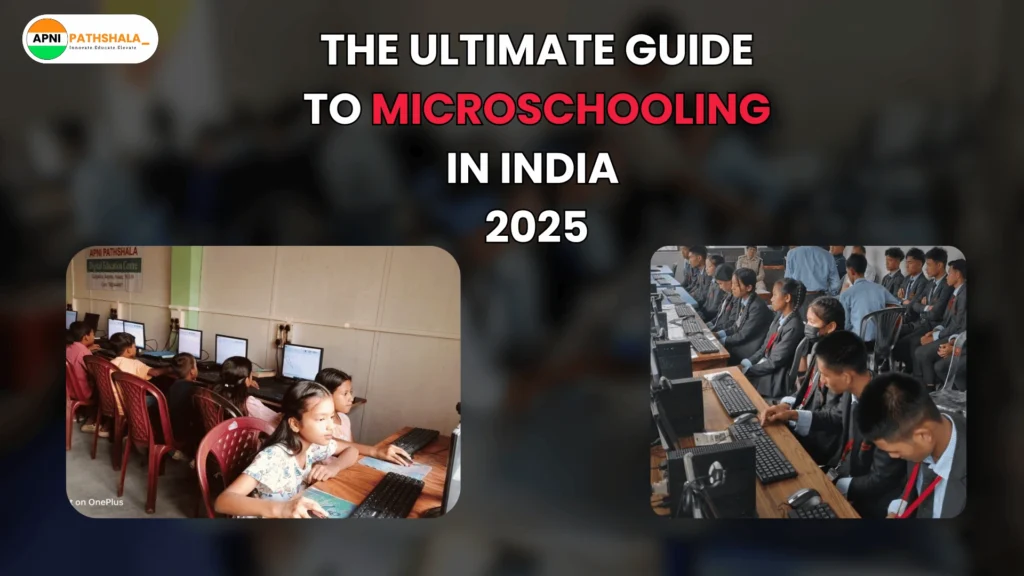Ultimate Guide to Microschooling in India – 2025

Let’s be real about it. Traditional schools haven’t changed much in the last 50 years. Rows of desks, rigid curriculums, standardized tests and kids stuck memorizing facts they’ll Google later. In 2025, parents across India are waking up and asking: “Is this really the best way for my child to learn?” If you’re one of those parents, curious, maybe even frustrated, you’re not alone. That’s why more and more families are turning to microschooling: a flexible, learner-first alternative that’s transforming education in real ways. This guide is written just for you. No beating around the bush. Just real, honest insights into microschooling: what it is, why it’s booming in India, and how you can be part of it. What is Microschooling? (Explained Simply) Microschooling is like taking the best parts of homeschooling and traditional school — and leaving out the bad stuff. It’s not about expensive private schooling or elite tutors. It’s about giving kids a real education that fits their pace, interests, and future. Think of it as a “learning pod” where your child is seen, heard, and guided, not just managed. Why Microschools are Gaining Popularity in India? Especially after COVID-19, Indian parents saw what schooling looked like from the inside. And many didn’t like what they saw. Endless homework, burnt-out kids, zero creativity, and typical learning. The cracks in the traditional education system became impossible to ignore. That’s when many parents started searching for real alternatives. And that’s how microschools in India quietly started gaining momentum. Microschools offer what the mainstream system often can’t: In cities like Bangalore, Pune, and Ahmedabad, microschools are now popping up in apartments, community halls, co-learning spaces, and even homes. Parents are calling it a breath of fresh air because it actually works. They’re not just looking for alternative education, they’re looking for meaningful education. And microschooling in India is offering just that: a model that’s small, personalized, and built around what children actually need to thrive. Whether you’re a working parent, a homeschooling family, or someone simply tired of outdated schooling methods, the rising trend of microschools might just be the shift you’ve been waiting for. Benefits of Microschooling for Children Here’s what real parents and educators are noticing: The biggest benefit? Microschools work because they’re built around the needs of the child, not the convenience of the system. This learner-first approach is why so many parents searching for alternative education in India are now turning to microschooling as a long-term solution. How to Start a Microschool in India? (Step-by-Step) Thinking of starting one? You’re not alone. Many parents and educators across India are realizing that meaningful learning doesn’t have to come from a big school building. And the best part? Starting a microschool in India is totally doable even if you’re starting from your living room. Here’s a simple, step-by-step guide to help you get started: Step 1: Define Your Vision Ask yourself: Clarity at this stage will shape your microschool’s foundation. Many successful microschools in India started with one parent or educator asking: “What if learning could be better?” Step 2: Understand the Legal Aspects To start a microschool in India, you don’t need CBSE or ICSE affiliation unless you’re planning to conduct board exams. Here’s how you can register: Also, consider aligning with NIOS (National Institute of Open Schooling) for exam readiness without the rigidity of mainstream boards, a popular option in the alternative education space. Step 3: Choose a Location You don’t need a fancy campus. Many thriving microschools run from: Just make sure it’s safe, quiet, and welcoming. Microschooling is more about the vibe than the visuals. Step 4: Pick a Curriculum or Learning Style One big reason microschooling in India is on the rise is the freedom to design your own curriculum. You can: Design it around the child, not the system. Step 5: Hire or Train Educators Microschools don’t need formal teachers in uniforms, they need passionate facilitators who love working with children. You can: In many community microschools, parents play a key role, making it collaborative and deeply personal. Step 6: Start Small, Grow Steady Most microschools begin with 5–10 learners, often neighbors, friends, or local families. Keep it tight-knit, focused, and flexible. Remember: this is a child-first model. And unlike large institutions, your microschool can evolve organically. Starting a microschool might feel bold but it’s also one of the most rewarding steps you can take if you truly care about personalized, alternative education for your child or community. And as hundreds of microschool founders across India are proving: it’s not just possible, it’s powerful. Challenges You Should Be Ready For Let’s keep it real. Microschooling isn’t all sunshine. There are certain challenges that you need to prepare for. Skepticism from Society Let’s face it, many people still believe that only “big schools” with uniforms and tall buildings count as real education.You might hear things like: “What about board exams?”, “Will your child get into college later?”, “Is this even legal?”, etc. But remember, every great shift in education was once questioned. The more people see how well alternative education in India is working, the more minds you’ll change. Finding the Right Educators or Mentors Microschools need teachers who are flexible, empathetic, and learner-focused. Not everyone fits this model, especially those used to rigid, top-down schooling. The key is to find (or grow) facilitators who love being with children, are open to unlearning and can guide without controlling. Sometimes, parents themselves become the best mentors in microschools. Ensuring Long-Term Sustainability Running a microschool isn’t just about teaching, it’s about planning, community building, and staying financially sustainable over time. You’ll need to think about: Many small microschools in India thrive by creating tight-knit learning communities where parents pitch in and costs are shared. But here’s the good news: Every challenge is also an opportunity. Microschooling isn’t just about starting a small school. It’s about reimagining education with courage, creativity, and community at the center. And India needs more pioneers like you — people
